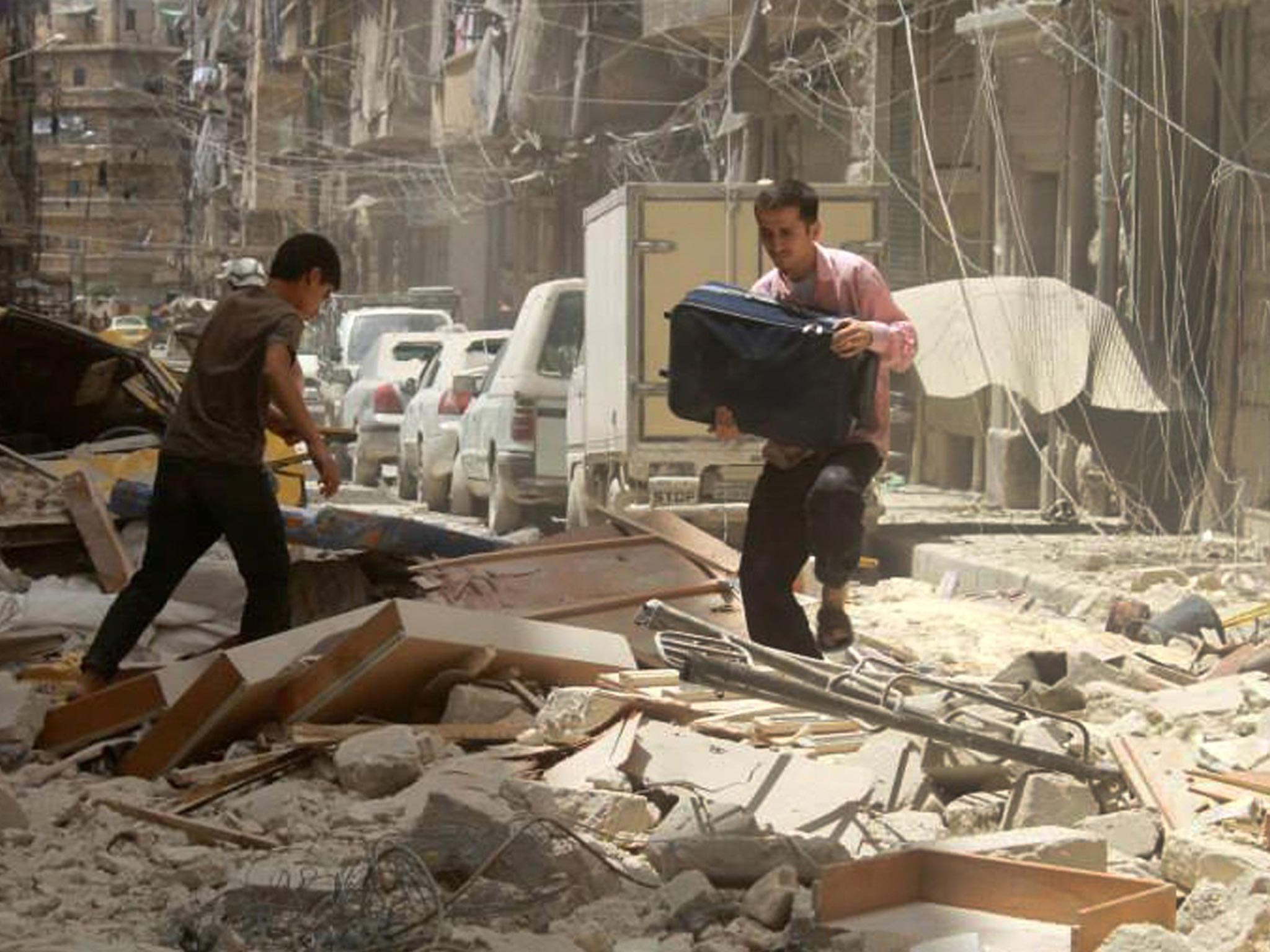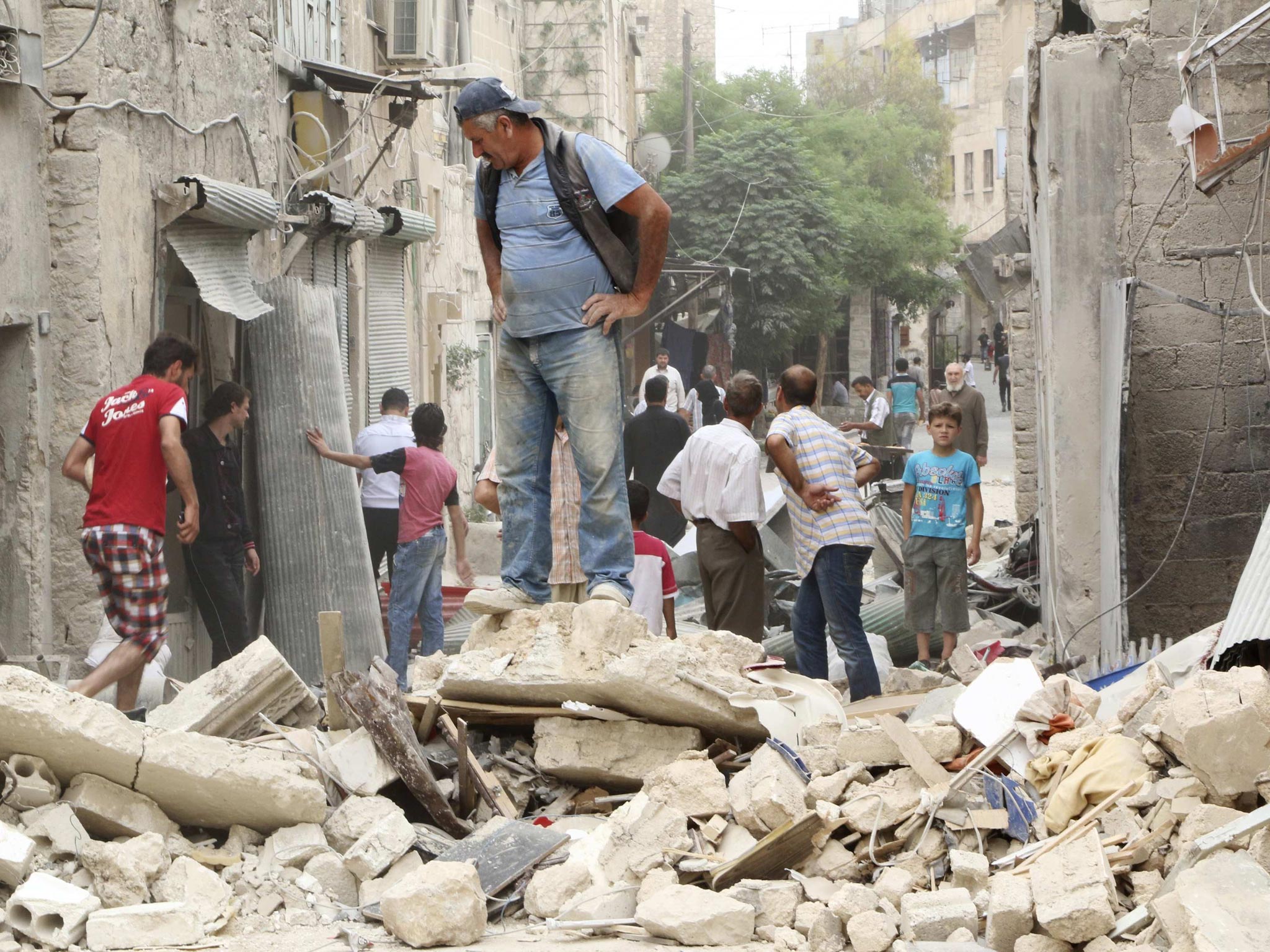Aleppo's Sheikh Najjar: The death of a once-rich city

Your support helps us to tell the story
From reproductive rights to climate change to Big Tech, The Independent is on the ground when the story is developing. Whether it's investigating the financials of Elon Musk's pro-Trump PAC or producing our latest documentary, 'The A Word', which shines a light on the American women fighting for reproductive rights, we know how important it is to parse out the facts from the messaging.
At such a critical moment in US history, we need reporters on the ground. Your donation allows us to keep sending journalists to speak to both sides of the story.
The Independent is trusted by Americans across the entire political spectrum. And unlike many other quality news outlets, we choose not to lock Americans out of our reporting and analysis with paywalls. We believe quality journalism should be available to everyone, paid for by those who can afford it.
Your support makes all the difference.Al-Qaeda City was an industrial zone, a vast plain of concrete and stone factories and cattle sheds and homes 10 miles north east of Aleppo, and when Bashar al-Assad’s army crashed up the main highway from Hama, lifting the rebel siege of Aleppo and careering on towards the Turkish border, the soldiers and tank crews were suddenly confronted by the biggest and most sophisticated fortress ever built by followers of the late Osama bin Laden.
Today, Syrian 155mm guns are banging off northbound shells from the olive and walnut orchards around what had been one of the country’s economic powerhouses, today reduced to square miles of smashed factories and burned chemical plants where, according to the Syrian commanders who had to smash their way into this place of pulverised iron, rubble and ash, hundreds of Islamist suicide fighters blew themselves up en masse rather than surrender. Colonel Saleh, sunglasses wrapped round a burned, lean face, stared at one great heap of sandwiched concrete in the middle of this grey wasteland and made a rare admission of loss for an officer of the Syrian army in this dangerous place. “The terrorists all blew themselves up with suicide belts,” he said. “They brought the buildings down on top of them as we attacked. I lost 27 of my soldiers storming just this one area.”
Miles of underground tunnels still lace their way beneath what had once been the Sheikh Najjar Industrial Zone, while men from al-Qaeda, Jabel el-Nusra, Jihad Islamia, the al-Sham Brigade and remnants of the old ‘Free Syria Army’ – all struggling to overthrow Assad’s regime – spent two years mining the buildings above ground, hacking lorry-wide passageways between their walls and cutting out sniper’s nests in every street and on every floor. What had been one of Syria’s newest industrial estates was transformed into a place of death; food stores and grain mills were turned into arms storage depots, their basements into dormitories for the hundreds of rebels who lived here.
It should take seven minutes up the highway from Aleppo to reach this extraordinary city of ruins, but the front lines of the Islamist forces north-east of the city – at some points scarcely 700 metres from the Syrian main supply route – so encroach on the countryside that we had to drive more than 30 winding miles along earthen laneways and behind ramparts of sand and concrete blocks to reach the ruins. It was a worrying trail, criss-crossed at night by tracer fire, that snaked past broken, evil-smelling sewage farms, across weed-strewn stretches of pre-war motorways and beneath the grass-covered tracks of the old railway line to Turkey, once the final stretch of track on Agatha Christie’s famed Oriental Express to Aleppo.
But there is nothing romantic about this battlefield. Just outside the rooftop headquarters where Colonel Saleh – like all his fellow officers, he wears no badges of rank – sits, surrounded by squawking radio sets, is a blasted-out Syrian tank. Its tracks have been shorn off, the front of the tank blown apart. Captured in the early months of the war, it was used by two suicide fighters in a vain attempt to smash the vehicle -- packed with explosives -- into the huge walls of Aleppo prison. The jail, in which hundreds of inmates are reported to have died of disease, hunger and ill-treatment over two years – and which was never taken by the rebel forces surrounding it – was not breached. “There were two suiciders inside,” Colonel Saleh says coldly. “One was Syrian, the other Egyptian.”
His colleagues are eager to talk of the huge number of foreign fighters who were based in this industrial complex – Chechens, they say, and Afghans and Egyptians, Saudis, Qataris, Algerians – and only rarely do they admit to the Syrians who also fought here against the government army. It is now a familiar format: Bashar al-Assad’s army are fighting "foreign terrorists" – an identical claim to that of the Americans when their forces were being assaulted in occupied Iraq a decade ago – who are being financed and armed from Turkey. Requests to see identification papers of the dead were, as usual, initially received with enthusiasm but "The Independent" was later told that they had been taken to an intelligence archive in the city of Hama.
But this was not just a geopolitical battle for the land north of Aleppo. You only have to drive a few miles east of the ruins to find a deserted but undamaged motorway with its modern, blue-painted signposts to Raqqa, the one large Syrian city today still totally under the control of rebel forces. The heavily defended Syrian industrial complex was the western front of an Islamist war zone that stretches for hundreds of miles to the east and finds its other front line on the western outskirts of the Iraqi capital of Baghdad.

Colonel Saleh and his men led me through acres of crushed factories, all surrounded by deep trenches and most gouged out by shell-fire and explosives. A headquarters dormitory was constructed beneath grids below a towering cereal feed mill whose outer walls had been smashed down, apparently by air attack – although the colonel denied this. Next to it was a factory for producing ‘zaatar’ – piles of crushed grain were still lying across the floor amid cartridge cases – from which tunnels had been dug up to five metres deep beneath the surrounding buildings, shorn up by earthen sandbags made out of animal feed sacks.
There was a vast fuel depot for trucks, partly underground, and I saw factory employees’ stone villas and gardens which had been buttressed with concrete and constructed into defensive positions so that it was possible for the Islamist defenders to moves across the city, above or below ground or across rooftops, crawling through the tunnels or driving through walls and concealed courtyards. Thousands of rounds of anti-aircraft shell cases were heaped in one garden, but there was one salient fact about this grim city of death: it had been built and defended by technical men, by strategists, by experts in design and defence whose interests went deeper than Islam. Did they come from Turkey? Afghanistan? Pakistan? Or were they local men trained outside the Muslim world, perhaps originally aided by supplies from the west, initially so promiscuously dispatched to anyone fighting the Assad regime?
For young men supposedly fixated by submission to God, the hundreds of Islamists who died here were remarkably self-regarding about their own identity. “Abu Mohamed” and “Hassan of Raqqa” had spray-painted their names beside an empty sheep and cattle market. “The Heroes of Yasser” – a suburb of Damascus – had proudly painted their names next to an underground bunker. The Syrian army spoke only vaguely of survivors and there was no mention of prisons for those who may have surrendered – one must imagine that few did – and there is no final figure for the hundreds of al-Qaeda dead. Colonel Saleh’s 27 men were just a few of the Syrian soldiers who also perished here. “Our sacrifice was very great,” one of his colleagues said bleakly.
In the world of the pseudo-experts of "terrorism", this was a masterpiece of what they like to call "al-Qaeda Inc." although, of course, the Islamists’ enemies here are those who support a ruthless regime which the west has vowed to destroy – and failed to crush – on many occasions. The battle north-east of Aleppo was undoubtedly a victory for the Syrian government. But the gunfire around us and the whispering of high-flying jets told another story: that this is a war which is far from won and the fighting and dying will continue, perhaps for years.
Join our commenting forum
Join thought-provoking conversations, follow other Independent readers and see their replies
Comments